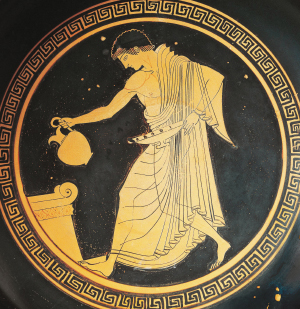
Author
Paul claims to be the author of this letter (1:1), and there has been no serious dispute about this claim.
Addressees
Paul first visited the Roman colony of Philippi on his second missionary journey (Acts 16:12) in the early 50s. The first converts were Lydia and her household (Acts 16:14–15), the jailer and his household (Acts 16:33–34), and others (Acts 16:40). The letter also names Epaphroditus (2:25) and Euodia and Syntyche (4:2). There were probably many more, though it is impossible to know how many.
Date and Place of Composition
We do not know for certain when or where Paul wrote the letter to the Philippians. Conclusions depend largely upon which imprisonment 1:13 refers to and upon what “palace guard” (1:13) and “Caesar’s household” (4:22) mean. Paul might have been in prison in Ephesus about AD 55, though this is not based on strong evidence; he certainly was in prison in Caesarea about AD 57–59 (Acts 24:22–27) and in prison in Rome about AD 60–62 (Acts 28:15–31). The reference to “Caesar’s household” does not rule out Caesarea, but Rome is more likely. Paul, therefore, probably wrote Philippians from Rome about AD 60–62, while Nero was emperor, and so the church was about ten years old when he composed this letter.
Occasion and Purpose
One of Paul’s main impulses for writing is to acknowledge the gifts from the Philippians (4:10–19). He also urges two individuals to be reconciled to one another, and he encourages the Philippians to remain faithful to the Lord (4:1–3). He reassures them about his circumstances and his plans to send Timothy in the future (chs. 1–2), and he warns of false teachers (ch. 3). Paul has the opportunity to write, which might not otherwise have arisen, because he is sending Epaphroditus back to Philippi (2:25).
Theology and Themes
Theologically, the most significant passage is the so-called hymn of Christ (2:5–11). Whether a hymn or not, it is one of the most exalted statements about Christ in the NT. With John 1:1–18, it sets out Christ’s divinity and preexistence: John 1 adds the detail that Christ is cocreator with the Father; Phil 2 has a point not mentioned in John 1; namely, that Christ is to be worshiped (2:10–11). Phil 2 also sets out, in remarkably dense form, that this supremely divine person descends to a humiliating death on the cross for our salvation.
Phil 2:6–11 is thus a brief account of the gospel, a theme prominent in other parts of Philippians (the word “gospel” appears 10 times: 1:5, 7, 12, 14, 16, 27 [twice]; 2:22; 4:3, 15; cf. also “the word of life” [2:16]). Paul also gives unity and the humility needed to foster such unity considerable attention (1:27—2:4). He stresses that justification is freely given by the words of God, through faith in Christ not the law (3:9). The letter is not primarily doctrinal; it also focuses on knowing Christ (3:8–11); “joy” (1:4, 25; 2:2, 29; 4:1) and “gladness/rejoicing” (1:18 [twice]; 2:17–18 [4 times]; 3:1; 4:4 [twice]; 4:10) are prominent, appearing 15 times in this short letter.
Outline
I. Introduction (1:1–11)
A. Opening Greeting (1:1–2)
B. Thanksgiving (1:3–8)
C. Prayer (1:9–11)
II. Paul’s Chains Advance the Gospel (1:12–26)
A. The Results of Paul’s Imprisonment (1:12–14)
B. Paul’s Rivals (1:15–18)
C. Paul’s Confidence in Death and Life (1:19–26)
III. Unity and Humility (1:27—2:18)
A. Life Worthy of the Gospel (1:27–30)
B. Imitating Christ’s Humility (2:1–11)
C. Do Everything Without Grumbling (2:12–18)
IV. Timothy and Epaphroditus (2:19–30)
V. Enemies of the Cross and Citizens of Heaven (3:1—4:3)
A. No Confidence in the Flesh (3:1–14)
B. Following Paul’s Example (3:15–21)
C. Closing Appeal for Steadfastness and Unity (4:1–3)
VI. Conclusions (4:4–23)
A. Final Exhortations (4:4–9)
B. Thanks for Their Gifts (4:10–20)
C. Final Greetings (4:21–23)
![]()
![]()
![]()

